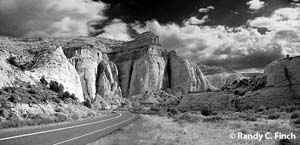In Sunday School this morning we were discussing
Psalm 102. At one point the teacher asked if anyone would like to share how God had become more real to them due to some painful event in his/her life. Several responded. Their stories were supplemented in a powerful way during our worship service when quite a few congregants participated in
Cardboard Testimonies. While the choir sang and the lights were down, people would step onto the stage with a large piece of cardboard in their hands. The spotlight was trained on these people so the signs were easily visible. Written on the cardboard was a message about some tragic event that took place in that person's life. After giving time for everyone to read the message, the cardboard was flipped over to reveal an encouraging message about how, through the help of God, tragedy was converted to healing, or at least the person had been given the wherewithal to endure the problem. It was a
powerful and
moving event. My wife was in tears and I, not usually very emotional, started to tear up as well. Stories of healing in the face of devastation seem to always bring out raw emotion in me. However, being the skeptic that I am, I always try to retain my rationality throughout.
While I know that most, if not all, of the people on that stage believe that it was God that saw them through the hard times, I am not convinced. I believe that most people have the innate ability to overcome life's problems on their own. It's just that some people doubt that ability and need to have an outside source of comfort to press them forward. As our preacher said this morning, if you are in a boat that you want to hold it in position in the face of a storm, you need an anchor. Keeping the anchor onboard (relying on self) allows the boat (ourselves) to be tossed about by the storm (life's circumstances). However, throwing the anchor overboard so that it is latched onto something external to the boat (God) will help hold it steady. This is a very good analogy, but I don't believe it applies in this circumstance.
I have known a number of people who are not believers that have been able to endure life's difficulties just fine. They had the ability to handle the rough situations in other ways besides turning to God. This suggests to me that we humans have the capacity to overcome our problems inherent in ourselves. However, I understand that it is not easy, and I can understand why people want to throw up their hands and rely on a more powerful source to help them through. In fact, a good unbelieving friend of mine, who has been and still is enduring a troublesome disease and whose wife is a cancer survivor, recently told me that he sometimes wishes that he had faith in a higher being. He thought that such a belief might bring more comfort during the bad times. Yet he, like me, believes that the existence of God is a matter of fact, not faith. In other words, God's existence or non-existence can only be determined through investigation, not by our feelings or emotions.
I am conflicted. It is sometimes difficult to discuss these things with people who sincerely believe that God has moved in a powerful way in their lives. I feel as though I am somehow shooting down that which they find most important in their lives. So, I try to tread lightly. Yet, as I told a believing friend of mine at lunch a few days ago when he mentioned the importance of faith. There is something even more important:
TRUTH!








